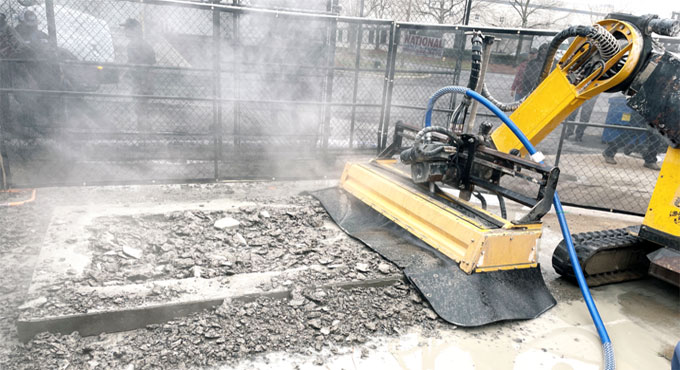NEWS | SOFTWARE | SHEET
How to Remove Concrete Using Hydrodemolition
Concrete removal is a challenging task that often involves heavy machinery, noise, and potential damage to the surrounding structure.
Traditional methods, such as jackhammering, can be time-consuming and disruptive. However, hydrodemolition, a relatively newer technique, offers a more precise, efficient, and environmentally friendly approach to concrete removal.
Hydrodemolition, also known as hydroblasting or water jetting, is a concrete removal technique that uses high-pressure water to remove deteriorated or unwanted concrete. This method is particularly effective for selective removal, where only specific areas of concrete need to be demolished without damaging the surrounding material.
The water jet used in hydrodemolition is typically pressurized between 10,000 to 40,000 psi (pounds per square inch), depending on the specific requirements of the project. This high-pressure water stream is capable of breaking down the concrete matrix, effectively washing away the material without causing micro-cracks or damaging the embedded rebar.
Benefits of Hydrodemolition
Hydrodemolition offers several advantages over traditional concrete removal methods:
- Precision: Hydrodemolition allows for highly accurate removal of concrete, preserving the integrity of the remaining structure. This is particularly useful in repair and restoration projects where only damaged or deteriorated concrete needs to be removed.
- Safety: Unlike traditional methods that generate dust, noise, and vibrations, hydrodemolition minimizes these hazards, making the work environment safer for operators and nearby workers.
- Environmentally Friendly: The water used in hydrodemolition can be collected, filtered, and reused, reducing the environmental impact. Additionally, the process produces no harmful emissions or airborne contaminants.
- Minimal Structural Impact: Traditional demolition techniques, like jackhammering, can cause vibrations that may weaken the surrounding structure. Hydrodemolition, on the other hand, is a non-vibratory method, ensuring that the remaining concrete and reinforcing steel are not compromised.
- Cost-Effective: Although the initial setup cost for hydrodemolition equipment may be higher, the speed and efficiency of the process often result in lower overall project costs. The precision of hydrodemolition also reduces the need for extensive repairs, further cutting down costs.
Applications of Hydrodemolition
Hydrodemolition is used in various applications, including:
- Bridge Deck Removal: Bridges often require partial or full deck removal during rehabilitation projects. Hydrodemolition is ideal for this task, as it can remove damaged concrete without affecting the underlying rebar or causing vibrations that could destabilize the structure.
- Parking Garage Restoration: Parking garages are susceptible to deterioration due to exposure to de-icing salts and environmental conditions. Hydrodemolition is commonly used to remove deteriorated concrete from slabs, beams, and columns, allowing for precise repairs.
- Dam Rehabilitation: Dams and other water-retaining structures require careful concrete removal to avoid compromising their integrity. Hydrodemolition provides a controlled method for removing concrete in these critical applications.
- Industrial Floor Removal: In industrial settings, concrete floors may need to be partially removed for repairs or upgrades. Hydrodemolition allows for precise removal without disturbing adjacent areas.
Steps Involved in Removing Concrete Using Hydrodemolition
Hydrodemolition is a specialized process that requires careful planning and execution. Below are the key steps involved in removing concrete using hydrodemolition:
1. Site Assessment and Preparation: Before beginning the hydrodemolition process, a thorough site assessment is necessary. This includes evaluating the condition of the concrete, identifying areas that require removal, and assessing any potential hazards. It's also essential to determine the appropriate water pressure and nozzle configuration for the job.
Site preparation may involve setting up barriers to contain the water and debris, ensuring proper drainage, and establishing a safe working environment for the operators.
2. Equipment Setup: Hydrodemolition requires specialized equipment, including high-pressure water pumps, nozzles, and robotic arms or manual lances. The choice of equipment depends on the scale of the project and the specific requirements of the concrete removal task.
Robotic hydrodemolition systems are often used for large-scale projects, such as bridge deck removal, where precision and efficiency are crucial. These robots are equipped with adjustable arms that can direct the water jet precisely where it is needed.
Manual lances are used for smaller or more detailed work, where the operator can directly control the water jet.
3. Concrete Removal Process: Once the equipment is set up, the hydrodemolition process begins. The high-pressure water jet is directed at the concrete surface, breaking it down into small particles. The water jet can be adjusted to remove varying depths of concrete, from surface layers to full-depth removal.
During the process, the operator must carefully monitor the progress to ensure that the desired amount of concrete is being removed without damaging the surrounding structure. In robotic systems, this is often done through a control panel that allows for real-time adjustments.
The removed concrete and water mixture, known as slurry, is collected and properly disposed of. In many cases, the water is filtered and reused, minimizing waste.
4. Post-Removal Inspection: After the hydrodemolition process is complete, a thorough inspection is conducted to ensure that all the deteriorated or unwanted concrete has been removed. The remaining structure is checked for integrity, and any additional removal or cleanup is performed as needed.
5. Surface Preparation: Following the removal of the concrete, the exposed surface may require additional preparation before new concrete is placed. This can include cleaning the surface, applying bonding agents, and addressing any exposed rebar.
Hydrodemolition often leaves a roughened surface, which is ideal for bonding new concrete. This mechanical interlock between the old and new material ensures a strong and durable repair.
Hydrodemolition is a cutting-edge technique that offers a safer, more precise, and environmentally friendly alternative to traditional concrete removal methods. Its applications in bridge deck removal, parking garage restoration, dam rehabilitation, and industrial floor removal demonstrate its versatility and effectiveness.
By understanding the process, benefits, and challenges of hydrodemolition, construction professionals can make informed decisions about when and how to use this technology in their projects.

Image Courtesy: conjet.com

